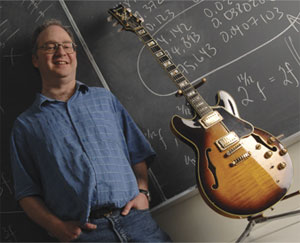 |
| Math prof Jason Brown and his Ibanez guitar.(Danny Abriel Photo) |
ItвҖҷs the most famous chord in rockВ 'n' roll, an instantly recognizable twang rolling through the open strings on George HarrisonвҖҷs 12-string Rickenbacker. It evokes a Pavlovian response from music fans as they sing along to the refrain that follows:
ItвҖҷs been a hard dayвҖҷs night
And IвҖҷve been working like a dog
The opening chord to A Hard DayвҖҷs Night is also famous because for 40 years, no one quite knew exactly what chord Harrison was playing. Musicians, scholars and amateur guitar players alike had all come up with their own theories, but it took a РВјУЖВБщәПІКҝӘҪұЦұІҘ mathematician to figure out the exact formula.
вҖңI started playing guitar because I heard a Beatles recordвҖ”that was it for my piano lessons,вҖқ says Jason Brown of РВјУЖВБщәПІКҝӘҪұЦұІҘвҖҷs Department of Mathematics and Statistics with a good laugh.В вҖңI had tried to play the first chord of the song many takes over the years. It sounds outlandish that someone could create a mystery around a chord from a time where artists used such simple recording techniques. ItвҖҷs quite remarkable.вҖқ
Four years ago, inspired by reading news coverage about the songвҖҷs 40th anniversary, Dr. Brown decided to try and see if he could apply a mathematical calculation known as Fourier transform to solve the BeatlesвҖҷ riddle. The process allowed him to decompose the sound into its original frequencies using computer software and parse out which notes were on the record.
It worked, up until a point: the frequencies he found didnвҖҷt match the known instrumentation on the song. вҖңGeorge played a 12-string Rickenbacker, Lennon had his six string, Paul had his bassвҖҰnone of them quite fit what I found,вҖқ he explains. вҖңThen the solution hit me: it wasnвҖҷt just those instruments. There was a piano in there as well, and that accounted for the problematic frequencies.вҖқ
Dr. Brown deduces that another GeorgeвҖ”George Martin, the Beatles producerвҖ”also played on the chord, adding a piano chord that included an F note impossible to play with the other notes on the guitar. The resulting chord was completely different than anything found in the literature about the song to date, which is one reason why Dr. BrownвҖҷs findings garnered international attention. He laughs that he may be the only mathematician ever to be published in Guitar Player magazine.
вҖңMusic and math are not really that far apart,вҖқ he says. вҖңTheyвҖҷve found that children that listen to music do better at math, because math and music both use the brain in similar ways. The best music is analytical and pattern-filled and mathematics has a lot of aesthetics to it. They complement each other well.вҖқ
